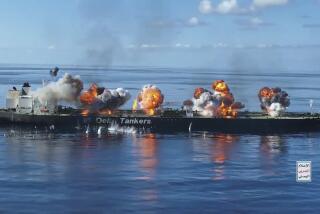U.S.-Escorted Tankers Steam Safely Into Gulf
- Share via
DUBAI, United Arab Emirates — U.S. warships escorted another convoy of Kuwaiti tankers into the Persian Gulf on Wednesday, steaming past Iranian missile sites and patrol ships without incident as they moved through the Strait of Hormuz and headed up the gulf toward Kuwait.
Maintaining the strict secrecy the Navy has imposed on all convoy movements, the three re-registered tankers and their escort of three warships slipped through the strait without being detected until they reached the western coast of the United Arab Emirates, where the U.S. assault carrier Guadalcanal was waiting for them.
Sea Stallion helicopters from the Guadalcanal flew ahead of them, sweeping the sea lanes for mines.
“They took everybody by surprise,” a shipping source in Dubai said. “They didn’t inform local officials they were coming and nobody really expected them to be coming from this direction anyway. It was quite clever of them.”
Joining the Guadalcanal about 50 miles off the emirate of Dubai, the three re-registered tankers, the Townsend, the Gas Queen and the Gas Princess, headed in single file toward Kuwait, where another convoy was waiting to go out.
The second convoy, which includes the Bridgeton, the supertanker that hit a mine on the first U.S. escort mission last month, has been loaded since last week and has been waiting to sail down the gulf.
Shipping officials had expected that convoy to get under way first and thus were surprised to see another convoy coming the other way.
“The Navy was very good at deception this time,” one shipping source said. “Everyone was looking north, so they came from the south. They didn’t even wait for the (U.S.) flags that the ships were supposed to fly. They’re still here in Dubai.”
The convoy did not entirely escape detection, however, as it sailed into the Strait of Hormuz, the strategic bottleneck that separates the Gulf of Oman from the Persian Gulf.
One shipping source said the convoy apparently picked up a “hitchhiker” as it entered the Persian Gulf--another tanker taking advantage of the Navy’s presence in an attempt to get secure passage through the strait.
A number of mines, widely believed to have been planted by Iran, have surfaced in the northern part of the Gulf of Oman in recent days, and Iranian patrol boats have stepped up their activity in the area.
Two vessels have been struck by mines in the Gulf of Oman over the last nine days. On Tuesday, a Norwegian chemical tanker, the Osco Sierra, was fired on by what was believed to be an Iranian patrol boat just south of the strait, in the same waters through which the convoy sailed less than 24 hours later.
Shipping sources said the Liberian-registered tanker was hit by a rocket-propelled grenade and strafed by machine-gun fire after apparently failing to respond to an order to stop. Iranian patrol boats frequently stop and spot-check vessels in the area to make sure they are not carrying war supplies to Iraq.
No Casualties, Slight Damage
There were no casualties and the tanker was damaged only slightly. Nevertheless, the incident heightened tension in the area because it was the first time since the Iran-Iraq War began more than seven years ago that a ship has been attacked outside the Persian Gulf.
Fears that Iran, in an effort to disrupt the U.S. convoys, might widen the war zone to waters south of the strait have been growing among shipping officials since a U.S.-owned tanker, the Texaco Caribbean, hit a mine several miles off the emirates’ port of Fujaira on Aug. 10.
It was the first time mines had been planted outside the Persian Gulf, in an area used both as a commercial tanker anchorage and, now, as the staging point for the U.S. convoys on their way up the gulf to Kuwait.
Iran, which has denied planting the mines, also disavowed responsibility Wednesday for the attack on the Osco Sierra, saying it was carried out by “those who intend to escalate tension in the Persian Gulf and the (gulf) of Oman.”
However, diplomats, shipping sources and other officials here have dismissed these denials--along with recent Iranian minesweeping maneuvers on both sides of the Strait of Hormuz--as partly propaganda and partly an attempt by Tehran to pressure the tiny emirates into completely disassociating themselves from the U.S. escort operation.
“Planting the mines and then offering to remove them seems to be Iran’s way of warning the emirates that the security of their waters depends on them (the Iranians),” and the withdrawal of foreign forces, one analyst said.
Nevertheless, this analyst and other regional specialists noted that for all their threatening rhetoric over the past few weeks, the Iranians have avoided a direct military confrontation with the superior U.S. forces in the region.
Indeed, Wednesday’s convoy reportedly passed close to several Iranian naval vessels without incident as it entered the Persian Gulf.
More to Read
Sign up for Essential California
The most important California stories and recommendations in your inbox every morning.
You may occasionally receive promotional content from the Los Angeles Times.













